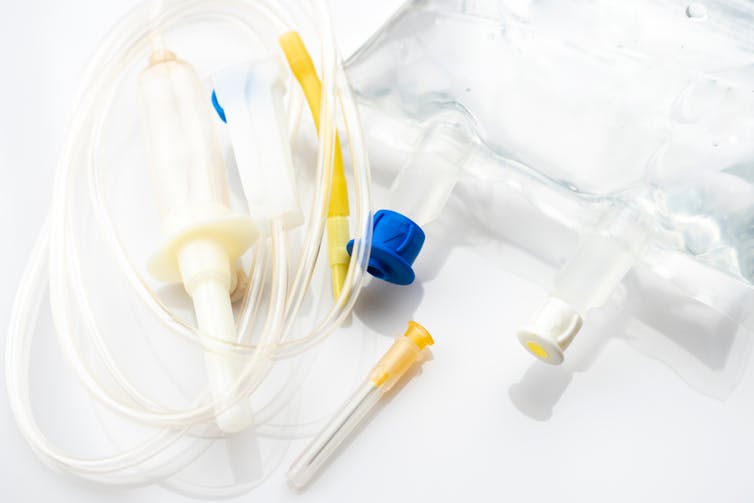Five ways hospitals can reduce their environmental footprint
- Written by Forbes McGain, Associate Professor, University of Sydney
Picture the environmental life cycle of many disposable surgical instruments. Iron ore from Western Australia is shipped to China and smelted, fashioned into stainless steel surgical instruments in Pakistan and exported as single-use instruments. In Australia, clinicians use these instruments once, then discard them.
So much that comes into patient contact is routinely used only once. This includes gowns, surgical drapes and covers for patients, anaesthetic breathing equipment, face masks and bed mats.
On top of this, energy is wasted in hospitals because heating, cooling and devices are left on when not in use. It’s not surprising then to learn that health care produces 7% of Australia’s carbon emissions; hospitals produce about half of this.
Here are five ways Australian hospitals can reduce their environmental footprint and improve their financial bottom line.
1. Employ a sustainability officer and get staff involved
A hospital sustainability officer examines ways to reduce energy use and waste, and encourages staff to participate actively in environmental projects. Although an “upfront cost”, in the absence of a sustainability officer activities known to save money and reduce our environmental footprint won’t occur.
At Melbourne’s Western Health, installing LED lights saved around 1,200 megawatt hours (Mwh) per year. This is similar to disconnecting around 165 Victorian houses from the electricity grid. The installation cost was paid back within two years.
Other sustainable activities included alternatively turning off one of the three hospital gas boilers during lull periods and installing large-scale (300kW) solar panels. These produce around 440 Mwh per year.
Since 2007, institutions that have similar daily energy requirements to 3,000 Australian homes or more have been required to annually report their energy use and greenhouse gas emissions to the federal government’s Clean Energy Regulator. Many medium to large hospitals fall into this range.
There aren’t any mandated requirements to reduce energy use or greenhouse gas emissions, but the reporting allows hospitals to gauge changes over time and strive to improve. In the absence of a hospital sustainability officer, hospitals hire expensive contractors to ensure the reporting requirements are met.
 Hospital equipment should be switched off when not in use.
from shutterstock.com
Hospital equipment should be switched off when not in use.
from shutterstock.com
Although some hospital staff are interested in workplace sustainability and want to make a difference, there are many barriers to doing so – both physical and psychological. Local sustainability action plans can be put in place to help staff work together to improve hospital sustainability. Activities can include staff in operating rooms being involved in lighting “switch-offs”, recycling different items and sending unused, out-of-date equipment to less advantaged countries.
2. Reuse surgical equipment where possible
Single-use medical equipment often costs more money than reusable equipment. Studies conducted at Western Health and Yale-New Haven Medical Center in the US found reusable anaesthetic equipment in operating theatres saved around A$5,000 a year per operating theatre.
The environmental footprint will vary according to the source of electricity. In the above studies, cleaning reusable anaesthetic equipment in Australia resulted in a slightly higher carbon footprint. This is because sterilisers and washers use a lot of electricity, which is derived mainly from coal in Australia. In the US, electricity is sourced from a less carbon-polluting energy mix (more natural gas in particular).
Research in Australia and Germany has shown reusing the standard breathing circuits used by anaesthetists to deliver oxygen and gases to anaesthetised patients does not increase the risk of microbiological contamination. Also, reusing these yearly for a six-theatre operating suite saved around A$5,500 and the equivalent electricity and water savings of one entire Australian household.
3. Recycle better
It is feasible to increase the amount of total recyclable hospital waste from very little to 35%, which saves money even in operating theatres. The most obvious first step to increase recycling rates begins with cardboard and paper products, which surprisingly even now may not be recycled.
It is also important to separate expensive hospital infectious waste from other less expensive, non-infectious waste.
 Plastic from IV bags and oxygen tubes could be recycled.
from shutterstock.com
Plastic from IV bags and oxygen tubes could be recycled.
from shutterstock.com
Several plastic types from hospitals can be recycled relatively easily, including PVC plastic. Some manufacturers in Melbourne are working with hospitals to convert PVC plastic from IV bags, face masks and oxygen tubes into agricultural pipes and children’s play equipment. More than 130 hospitals in Australia and New Zealand are involved.
All recycling efforts require collaboration between clinical staff, infection prevention, environmental services and recyclers.
4. Avoid potent anaesthetic greenhouse gases
Anaesthetic gases are hundreds to thousands of times more potent greenhouse gases than CO₂. Desflurane and nitrous oxide are the most problematic, but can be substituted without altering patient care.
These gases do have more rapid anaesthetic onset and offset durations, but other, less environmentally harmful gases can be used just as effectively. Due to familiarity and perhaps drug marketing, desflurane and nitrous oxide remain in common use by anaesthetists.
Several Australian hospitals have saved A$30,000 and hundreds of tonnes of CO₂ annually by substituting desflurane with other anaesthetic gases. Victoria’s health system alone could save hundreds of thousands of dollars a year by such substitution.
5. Advocate and collaborate towards a low-carbon, low-waste system
It’s important to minimise patients’ need for care in a hospital as much as possible. This will involve increasing the role of general practitioners, public health care and disease prevention. We should also avoid unnecessary and potentially harmful tests, such as performing a variety of common blood tests on all pre-operative patients (even those who don’t need them).
The health-care system can’t become low carbon and low waste without leadership, incentives and direction. In 2008 the UK Climate Change Act legislated for an 80% reduction in CO₂ emissions by 2050 and formed the Sustainable Development Unit – a national body charged with reducing health care’s CO₂ emissions. By 2017 there was an 18% increase in UK health-care activity, yet an 11% reduction in CO₂ emissions. Nothing like this exists in Australia.
Australia’s current ad hoc, piecemeal approach by engaged clinicians to improve hospital sustainability and translate this to all hospitals is not working. The federal government, which funds around half of all health care, could promote environmental sustainability by:
It’s time for more sustainable use of health care’s financial, environmental and social resources. Our health depends on it.
Authors: Forbes McGain, Associate Professor, University of Sydney
Read more http://theconversation.com/five-ways-hospitals-can-reduce-their-environmental-footprint-90390



















